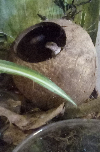Anoles, Quails, and Maybe Cattails
Anolis Lizards
Anoles are small lizards, sometimes seen as simple or common compared to larger lizards like komodo dragons or frilled lizards. Although they are small, Anoles are one of the most fascinating, diverse, and beautiful groups of lizards.

Basil, a female brown anole, pokes her head out of her coconut perch.
List of Anolis Species
- Brown Anole, Anolis Sagrei
Although they are an invasive species, and are considered pests, these are still beautiful anoles worthy of appreciation.
Appearence:
Males: Males are generally larger, and measure around 4-6 inches. They are brown in color, and have large red dewlaps used to attract mates and defend territory.
Females: Females are smaller than the males, and also have smaller dewlaps. You can easily identify a female brown anole by their lateral (back) pattern, which the males lack. This lateral pattern varies between individuals, with scalloped, diamond, stripe, and cardioid patterns.
Diet:
Brown anoles are mostly carnivores. They feed on small invertabrates, and sometimes smaller lizards and amphibians. Brown anoles will go after any small thing that moves.
Conservation Status:
Least Concern
Natural Range:
The Bahamas & Cuba
- Green Anole, Anolis carolinensis
Green anoles are small, green lizards with a red dewlap. These anoles can change from a bright green to brown, which can sometimes confuse them with brown anoles.
Appearence
Males:
Males are often a brilliant lime green, with a pink/red dewlap. Some individuals have blue scales around their eyes.
Females:
Females are smaller in both body size and dewlap size, but are still impressive. Like males, individuals may have blue scales around their eyes.
Diet:
Green anoles are carnivores, eating inverts and small vertabrates. Although they usually eat animal matter, they have also been seen eating fruit, and even drinking from hummingbird feeders!
Conservation Status:
Least Concern
Natural Range:
South-eastern U.S.
- Cuban Knight Anole, Anolis equestris
These are large lizards, growing as large as a foot or more. As their name suggests, these lizards are native to Cuba. Unfortunately for Soutern U.S. wildlife, Cuban Knight anoles have become an established invasive in Florida.
Appearence
Males:
Females:
Diet:
Conservation Status:
Least Concern
Natural Range:
Cuba
- Allison's Anole, Anolis allisoni
Appearence
Males:
Females:
Diet:
Conservation Status:
Least Concern
Natural Range:
Cuba
- Agassiz Anole, Anolis agassizi
Appearence
Males:
Females:
Diet:
Conservation Status:
Least Concern
Natural Range:
Columbia
- Proboscis Anole, Anolis proboscis
As the name suggests, males of this species have a long nose. This lizard is very unique, but is sadly endangered.
Appearence
Males:
Females:
Diet:
Conservation Status:
Endangered
Natural Range:
Ecuador
To learn more about the diverse world of anoles, visit Anole Annals, the best anolis information on the web.